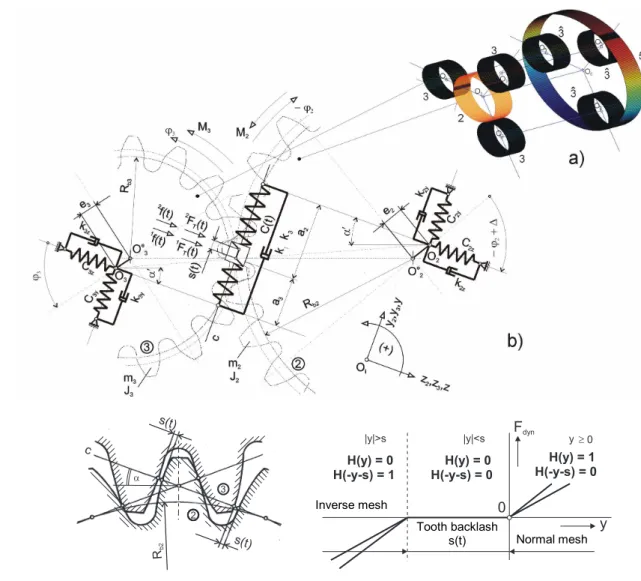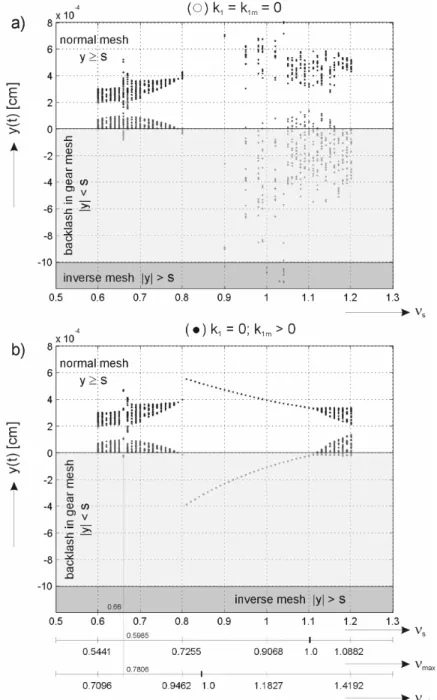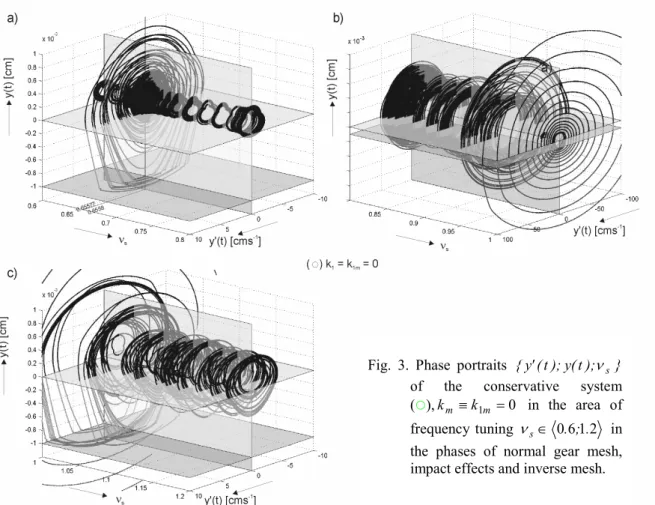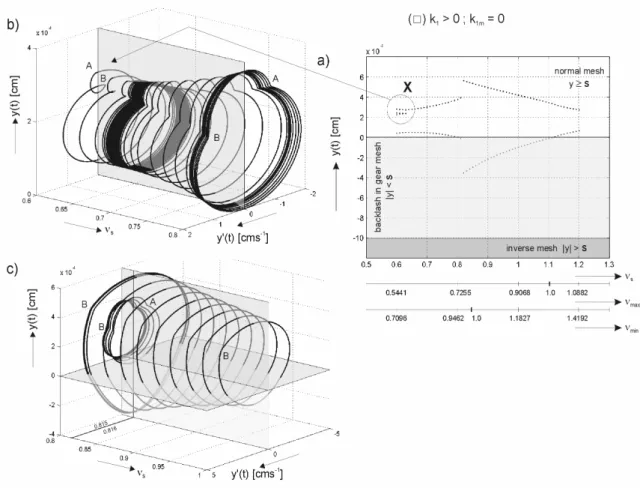Bifurcation phenomena in internal dynamics of gear systems
M. Hortel
a,*, A. Škuderová
aaInstitute of Thermomechanics, v.v.i., Czech Academy of Sciences, Dolejškova 5, 182 00 Praha 8,, Czech Republic
Received 10 September 2007; received in revised form 1 October 2007
Abstract
The impact effects in gear mesh represent specific phenomena in the dynamic investigation of highspeed light transmission systems with kinematic couplings. They are caused of greater dynamic than static-elastic de-formations in meshing gear profiles. In term of internal dynamics they are influenced among others by time hete-ronomous stiffness functions in gear mesh and resonance tuning of stiffness level. The damping in gear mesh and in gear system is concerned significantly in the amplitude progress, greatness and phase shift of relative mo-tion towards stiffnessfunction alternatively towards its modify form in gear mesh. In consequence of these and another actions rise above resonance characteristics certain singular locations with jump amplitude course. © 2007 University of West Bohemia. All rights reserved.
Keywords: nonlinear dynamics, parametric systems, motions with impacts
1. Introduction
The problems of internal dynamics of transmissive systems with kinematic couplings – gear wheels – both systems with direct and split power flow is the necessary component of the analysis of external dynamics of these mechanical systems.
The signification of the above mentioned is greater by problems of non-linear time heter-onomous i.e. parametric systems with great range still both theoretically and experimentally unresolved – unknown parameters which significantly influence their dynamic properties. In given systems they are especially the frictional forces in gear mesh of elastic supported wheels and the damping forces in gear mesh both in the phase of mesh and in the phase of impact effects when dynamic deformations are greater than static-elastic these.
For the motion equations composition of mathematical physical model of planetary sys-tems, alternatively their special cases with kinematic couplings – gears has been applied La-grange´s method. The solution of that way created motion equations of mechanic discrete sys-tem in the form of weakly and strongly nonlinear parametric ordinary differential equations of second order was carried out by means of
1) analytical: transformation of boundary differential problem onto equivalent system of integrodifferential equations with solving kernel in form of Green´s resolvents and E.Schmidt´s method of kernel splitting [2],
2) numerical: on the simulation model of system in MATLAB/Simulink [7].
For the dynamic analysis phenomena in such mathematical-physical models of planetary for example pseudoplanetary systems – reducers the motion can be described by systems of deterministic weakly a strongly non-linear parametric equations in the form [1]
*
). , H , , b , a ( ) ( ) , H , I , , ( ) , H , V , U , Y , , ( )) ( ( sgn ) ( ) H , D , D ( ) H , , ( n n K K n K n n n K K i K i F v w C v C v w v w K v K v M = + + + + > > 1 1 1 1 1 1 1 (1)
Here v means generally the m-dimensional vector of displacement of system vibration, )
(v
wK K-th power of vector v, which is defined by expression wK(v)=D(w(v)wK 1(v)). ))
(
(w v
D denotes the diagonal matrix, whose elements at the main diagonal are comprised by elements of vector w(v) v. Furthermore M is the matrix of mass and inertia forces, 1K
and K
1
K are the matrix of linear and non-linear damping forces, 1C and KC are the matrix of linear and non-linear reversible forces and F( ) is the vector of non-potential external ex-citation with components an,bn and with the phase angle . H is the Heaviside´s function, which allows to describe the motions – contact bounces – due to strongly analytical non-linearities, for example due to technological tooth backlash s( )*. Corresponding linear and non-linear coefficients of damping are denoted by , i D,Di linear parametric stiffness
func-tion by the symbols Yn,Un,Vn and linear parametric functions, so-called parametric
non-linearities, by the symbol In. and are the coefficients of mesh duration and amplitude
modulation of stiffness function 1C. Derivative by non-dimensional time are denoted by dashes, = ct, c … mesh frequency, t… time.
The contribution reassumes onto hitherto published works [3],[4],[5] and goes out from the solution of special case of improved discrete mathematical-physical model of kinematic pairs of teeth wheels from one branch of pseudoplanetary systems, s. Fig.1, which represents system with six degrees of freedom, and deals especially with refinement of damping forces and their properties namely both in the phase on normal mesh and in the phase of contact bounce and their influence on the resonance characteristics of given systems.
The relative motion as the measure of dynamic loading in the gear mesh, i.e. in the course of mesh line, can be described for the generally elastic supported system with bearing motions
{
y3,2;z3,2}
of the gear pairs 3,2 by respecting so-called run-out of pitch circles, which are modelled by eccentricities e3,2, in the form [1]) ( f ) sin( e sin e y y R R ) (
y = b3 3 + b2 2 + 3 2 + 3 3 2 2 +1,2 , (2)
where 1,2f( ) is the deflect function, or the deviation of the cog side form from the ideal in-volute, is the phase angle of angular displacement between eccentricities e3,2 and Rb3,2 are radii of basic circles. This relative motion represents the measure of dynamic load in gear mesh because the dynamic force can be characterized by relation Fdyn=1C( )y( ).
The analytical form of the resulting stiffness function of spur gearing in mesh can be ex-pressed by Fourier´s series in form [1],
( )
1 sin[
(
2)
]
cos ,4 2 ) 1 ( ) ( 1
max n n t
n C C t C c n n s = + = (3) *
Explain in more detail of the tooth backlash as a function s( )= f(sk,y3,y2,e3,e2, 3, 2, , ), where sk is the
Fig. 1. The substitutive mathematical – physical model of kinematic pair of gears (b) of pseudoplanetary system with double satellites – (a), the technological teeth backlash and the values of Heaviside´s functions H in the areas of gear mesh with clearances (c).
where the mean stiffness is defined by
[
1 (2 3)]
. 2) 1 (
max
max + +
= C C
Cs (4)
The symbol =CminCmax 1 represent the amplitude modulation of resulting stiffness function
in gear mesh, Cmin,Cmaxare maximal and minimal values of stiffness in gear mesh and is coefficient of mesh duration, which indicates how many teeth pairs is at any one time in mesh at mesh line. In extreme cases, for example =1, is during the mesh time at mesh line only one teeth pair, in the case =2 are two pairs of teeth whole time in mesh. In these cases verges the parametric system i.e. in the stiffness with time heteronomous system on the sys-tem with constant coefficients. This fact markedly affects the dynamics of syssys-tem and is con-nected with the size of amplitude of relative motion in gear mesh. That is influenced by time duration of mesh on that which potential stiffness level of appropriate reversible force. In the stiffness of teeth is respected in the next application only the stiffness of the separate cogs and their fixation into a solid half-space, discs are considered absolutely solid.
c)
Tooth backlash
s(t) Normal mesh Inverse mesh
Inverse mesh
Normal mesh Tooth backlash
The next factor which influences qualitatively and quantitatively the course of y(t) is the friction in gear mesh or frictional forces in the motion rolling – sliding of kinematic pair – gearing. They induce the variance of originally considered constant preload
. konst ) M ( M
M ==== 3 2 ==== on Mv ====M±±±± MT, where MT is the additional moment from friction forces.
The friction forces in the gear mesh constitute the separate chapter in the frame of tri-bological process of lubrication. Theory of the EHD lubrication in gear mesh of the finite width at the line contact under the rolling and sliding contact is on the present-day one of more developed areas. The gear profiles of kinematic pairs pursue complicated motion rolling - sliding namely sliding resulting as from the gear mesh geometry so from the relative mo-tions of elastic bearings, i.e. momo-tions caused as by the elasticity of bearings so by the wheel run-out. Purely rolling motion in gear mesh occurs only in the pitch point on the mesh line by absolutely solid bearing of wheels. In this contribution is applied for qualitative complying with friction force FT(t) as the zero approximation only very estimative theory of Cou-lomb´s friction )], z z ( [ sign )]} sin( e sin e [ { sign ) t ( ) t ( C } H )] t ( s ) t ( y [ H ) t ( y { f ) t ( F e e e e T T 2 3 0 2 2 2 3 3 3 0 3 2 3 2 2 1 & & & & + + + + = + + (5)
where fT is the coefficient of dry friction, (t) is the function with values 0.5;1;0;-1;-0.5 with regard to momentaneous position of gear mesh at mesh line of gearing, that correspond-ing with the resultcorrespond-ing stiffness function and with the sense of action of friction force (s. [7], p.17) and 0
3
2 e
e + is the Kronecker´s symbol.
2. To the patterns of damping in gear mesh of one branch of pseudoplanetary gearing system
The analysis of dynamic features of solved special case of general non-linear parametric, i.e. time heteronomous, system with kinematic couplings – spur gears is in this contribution aimed to the investigation of reasons of forms of resonance characteristics of given mathe-matical-physical model both by
a) the conservative system in gear mesh*and b) non-conservative system.
By reason that in such complicated parts of transmissive systems are still unknown neither approximate data about damping properties or about damping patterns both in gear mesh and also in the connection with fixation into gear rim and discs including hubs like unit, will be this damping simulated by means of different functional relation both in the area of gear ma-terial at normal or inverse mesh incl. corresponding parts of gear rim and discs, and the influ-ence of viscous damping in the area of technological gear backlash, i.e. the influinflu-ence of oils in the phase of teeth profile contact loss. The lightening holes in discs of wheels also markedly
*
influence the damping, similarly the viscous damping of lubricant mediums is dependent on their temperature etc.
In this study will be the influence of damping or the damping forces in system of motion equations (1) of given model of mechanic system represented – modelled by the terms in form
. , K )) ( ( sgn ) ( ) H , D , D ( ) H , , ( K K i K
i pro 1 23
1 1 1 1 1 = + > v w v w K v K (6)
Combinations of damping in gear mesh conser-vative system in gear mesh linear damping in gear mesh - L
quadratic damping in gear mesh - Kv
cubic damping in gear mesh - Ku
L + Kv L + Ku L + Kv +
Ku
Kv + Ku
k1 0
×
×
×
×
×
×
×
×
×
×
×
×
× ×
×
×
×
×
×
×
×
× ×
×
×
×
×
×
×
×
×
×
k2 0
×
×
×
×
×
×
×
×
×
×
×
×
×
×
×
×
×
×
×
×
× ×
×
×
×
×
×
×
×
×
×
×
k3 0
×
×
×
×
×
×
×
×
×
×
×
×
× ×
×
×
×
×
×
×
×
×
×
× ×
×
×
×
×
×
×
×
k1m 0
×
×
×
× ×
×
×
×
×
×
×
× ×
×
×
×
×
×
×
× ×
×
×
×
×
× ×
×
×
×
×
×
k2m 0
×
×
×
× ×
×
×
×
×
×
×
× ×
×
×
×
×
× ×
×
×
×
×
×
×
× ×
×
×
×
×
×
k3m 0
×
× ×
×
×
×
×
×
×
×
×
× ×
×
×
×
×
× ×
×
×
×
×
×
×
× ×
×
×
×
×
×
Symbol of mar-ked so-lution in figures
Variation a b c d e f g h
Note: k1,2,3 … material damping in gear mesh; k1m,2m,3m … viscous damping of lubricant mediums in the teeth
backlash (without contemplation of temperature influence;1 – linear, 2 – quadratic, 3 – cubic
Tab. 1. Combinations of damping in gear mesh.
The several proposed functions of linear and non-linear damping in gear mesh, eq. (6), for which have been solved the resonance and bifurcation parametric characteristics of given con-servative and non-concon-servative homogeneous system (F(an,bn, ,H, )====0, s. eq. (6)) with time variable stiffness C(t), eq. (3), in gear mesh are presented in Tab.1 and denoted by letter a … h, several combinations material or viscous damping in these variations subsequently with symbols … for conservative system, , , … for combination of that which vari-ation.
All the resonance bifurcation characteristics have been solved for =1,569; =0,5879;
[kg] 10 123 3 ]; [Nmm 10
4 5 -1 = 3
= . m , .
Cmax red . The values of linear material damping k1 and
linear viscous damping in tooth backlash k1m are considered in all next given examples of
so-lution identical, i.e. k1 =k1m =3,95[Nmm-1s], which corresponds to proportional damping 062
. 0 =
= m .
here considered parametric i.e. with time variable potential stiffness function C(t) in gear mesh and the function of friction force FT(t).
In relation to the limiting extent of the contribution we present in next only some proper-ties of bifurcation resonance characteristics of system with variant damping from Tab.1.
Fig. 2. Bifurcation resonance characteristics of the system with the linear variant damping ( ),km k1m =0 and ( ),k1=0;k1m>0 in the area of frequency tuning s 0.6;1.2 in the phases of normal gear mesh, impact effects and inverse mesh.
Two bifurcation resonance characteristics of system from Fig.1 are illustrated in Fig.2. The first characteristics (Fig.2a) presents the conservative system ( ) with damping coeffi-cients 0km k1m = in the range of mean tuning s 0.6;1.2 of resulting stiffness C(t) in
damping ( ), i.e. with damping coefficients km =0;k1m >0. The system is damped in this case only in the phase of teeth profile contact loss, in the phase of normal mesh i.e. y(t)>0is this system conservative. In the Fig.2 are color coded the area of normal gear mesh for y(t) 0, the area of the phase of teeth profile contact loss ( y(t)<s(t),s(t)Kthe tooth backlash) and the area of inverse mesh ( y(t)>s(t)).
In the Fig.2a is plotted the bifurcation characteristics of conservative system ( ),km k1m =0. That is about the mean tuning value s 0.66ordered, with sincreasing,
characteristics, in the interval s
(
0.8;0.9)
hardly grows to infinitude and in the interval2 1 9 0. ; .
s again decreases to the finite amplitude with chaotic character. The reason of the jump phenomena is caused by the resonance tuning at the corresponding stiffness level of the function C(t), alternatively C(t)(H1+H2), in the given case at the minimal stiffness level
min
C . In the vicinity of the jump s 0.66 i.e. 7806min =0. against 5985max =0. , next then
in the interval s
(
0.8;0.9)
is the solved system in the vicinity s 0.85 at the stiffness levelmin
C directly in the resonance min =1. For the relative motiony(t)<0converts the resulting stiffness function C(t) into the modify stiffness function C(t)(H1+H2) (H1,H2 … Heaviside´s function), where the phase shift of amplitude y(t) towards the stiffness levels Cmin or Cmax of the function C(t)(H1+H2) influences the time course interval of the amplitude size of the rela-tive motion y(t).
Fig. 3. Phase portraits {y'(t);y(t); s} of the conservative system ( ),km k1m =0 in the area of
The similar situation is also in the case of the bifurcation resonance characteristics of non-conservative system with the linear variant damping ( ),k1=0;k1m >0, s. Fig.2b, where the
energy dissipation i.e. the damping k1m by the teeth contact loss in the gap influences the characteristics form. Qualitatively this case differs from the previous one, s. Fig.2a, primarily in this that the bifurcation resonance characteristics courses have more stable continuous character in the whole pursued interval s 0.6;1.2 , particularly in the interval
1 1 8 0. ; .
s . The bifurcation disappearance in the vicinity s 0.8 as well as the bifurcation
issue in the vicinity s 1.1 is influenced above all by the teeth contact loss i.e. by 0
<
) t (
y by the transition of function C(t) onto the modify stiffness function C(t)(H1+H2) with three stiffness levels Cmin, Cmax,C(t) = 0. The damping and the teeth bounces with ef-fect of the phase shift y(t) towards C(t) alternatively C(t)(H1+H2) change the time conditions for the amplitude progress y(t). The growth of the amplitude y(t) is influenced by the increas-ing values min alternatively max. The resonance amplitude decreases and till in the vicinity
0 1.
max the bifurcation effects come up again. The stationary - steady state of the motion
y(t) thus converts in consequence of the changes of the modify stiffness function
C(t)(H1+H2) into the heterodyne motion. The illustration of these facts have be seen from
the phase portraits of the conservative system (Fig.3) and non-conservative one (Fig.4). The more detailed analysis of these phenomena is given in [6].
Fig. 4. Phase portraits {y'(t);y(t); s} of the non-conservative system wi-th wi-the linear variant damping ( ),k1=0;k1m >0in the area of
In conclusion of this paper we pointed at the phenomenon which is not caused by sources for the bifurcation issues, which are analysed in Fig.2. In Fig.5a it deals with “DETAIL X” with “bifurcation character”, which appears in the system with the variant damping ( ),k1>0;k1m>0. As is from Fig.5b evident, this fact is caused by the turning of points of discreteness A,B at the gear mesh skipping from one stiffness function level C(t) in the area of normal mesh on the other, [6]. These loops disappear in the vicinity s 0.6 with the in-creasing frequency tuning and only melt into the discreteness location A,B. The singular resonance amplitude jump location in the vicinity max 0.815 and the next progress of the resonance characteristics is evident from the phase portrait in Fig.5c.
Fig. 5. Bifurcation resonance characteristics and phase portraits {y'(t);y(t); s} of the non-conservative
sys-tem with the linear variant damping ( ),k1 >0;k1m >0in the area of frequency tuning s 0.6;1.0 in
the phases of normal gear mesh and impact effects in mesh.
3. Conclusion
The mentioned exemplifications of damping influence bring out some partial results of analysis of the internal dynamics of strongly non-linear parametric systems which are excited purely parametrical i.e. by only mentioned modify resulting stiffness function C(t)(H1+H2) in the gear mesh.
- the size of tooth backlash s(t), which is time variable for example in consequence of elas-tic supporting of wheels and possible run-out of pitch circles meshing wheels,
- the value of the coefficient of mesh duration which determines at which stiffness level
(potential level) Cmax or Cmin and in what time interval run the solution of relative motion in gear mesh,
- the value of the amplitude modulation =CminCmax 1,
- the resonance tuning of stiffness level at which the solution of relative motion just run, i.e.
the relation between the exciting mesh frequency c and eigenfrequencies
1 min max, 2
min
max, =C mred ,
- the form of modify resulting stiffness function CM HC(t, , ) in gear mesh in the
framework of vibration of system with impact effects in mesh, where H is Heaviside’s function,
- the phase shift of relative motion y(t) towards stiffness function C(t, , ) alternatively
towards its modify formCM HC(t, , ) caused by linear and non-linear damping effects both the material in gear mesh and temperature dependent viscosity of lubricant in the area of tooth backlash.
Detailed analysis of influence of parametric vibrations and influence of system parameters on the quality and quantity of amplitude of relative motion y(t) will be the theme of next re-search, which is yet not finished. The closing results and principles will be published in next works.
Acknowledgement
The work has been supported by the grant project of Czech Science Foundation (GA CR) Nr. 101/07/0884 and by the research project AVOZ 20760514 in Institute of Thermomechan-ics AS CR, v.v.i.
References
[1] M. Hortel, Dynamics of non-linear systems with kinematic couplings. N AV CR, Prague, in print. (in Czech).
[2] M.Hortel, Integrodifferentialgleichung in der Analyse von Phänomenen in nichtlinearen parametererregten Systemen. Integrodifferential equations in the Analysis of phenomena in non-linear parametric excited systems. Recent Advances in Mechanics of Solids and Fluids. Bd. 1-3, Technical University of Vienna, 28. November 1997. (in German).
[3] M. Hortel, A. Škuderová, To some dynamic properties of parametric - heteronomous systems with internal kinematic couplings and split power flow. Colloquium Dynamics of Machines 2007, Prague, IT AV CR, v.v.i., 2007, pp. 85-94. (in Czech).
[4] M. Hortel, A. Škuderová, To influence of damping on impact effects in gear mesh. Proceedings 22nd con-ference with international participation Computational mechanics 2006, Volume 1, pp.179-186. (in Czech).
[5] M. Hortel, A. Škuderová, Influence of linear and nonlinear damping on the stability of motion of kinema-tic pairs of gears. Engineering Mechanics 2006,Prague, 2006, pp. 104-105.
[6] M. Hortel, A. Škuderová, To numerical analysis of dynamic phenomena in non-linear parametric systems with impacts in gear mesh. (in print) (in Czech).





